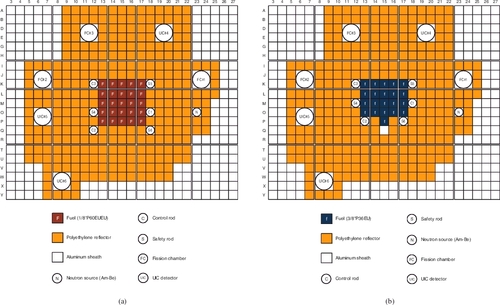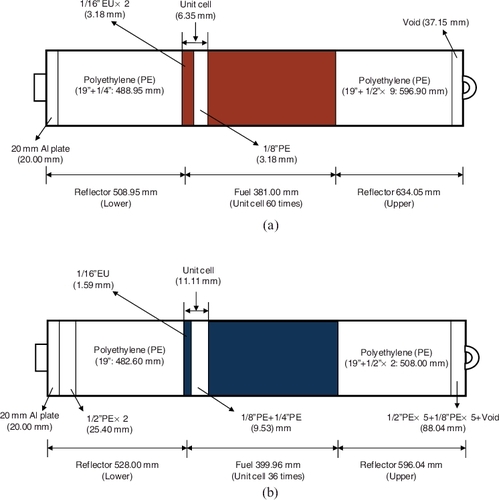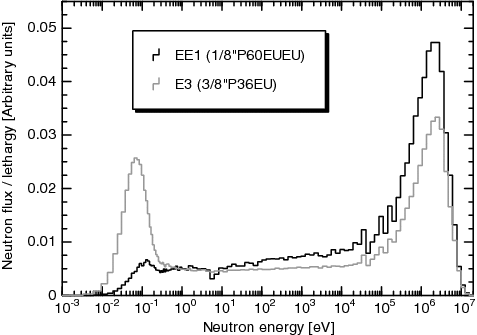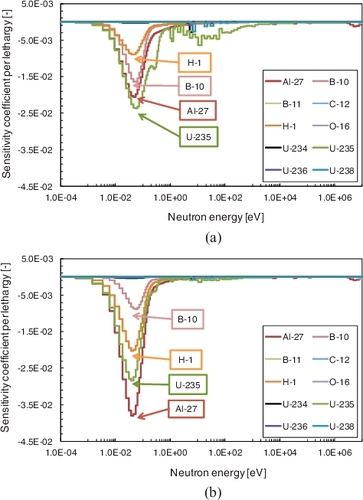 ?Mathematical formulae have been encoded as MathML and are displayed in this HTML version using MathJax in order to improve their display. Uncheck the box to turn MathJax off. This feature requires Javascript. Click on a formula to zoom.
?Mathematical formulae have been encoded as MathML and are displayed in this HTML version using MathJax in order to improve their display. Uncheck the box to turn MathJax off. This feature requires Javascript. Click on a formula to zoom.ABSTRACT
Uncertainty quantification is conducted for the criticality of excess reactivity and control rod worth obtained at the Kyoto University Critical Assembly (KUCA). By combining SRAC2006 and MARBLE code systems, the sensitivity coefficients of the cross sections for aluminum-27 (27Al) comprising mainly of core components are large in the solid-moderated and -reflected cores (A cores) at KUCA. Also, the uncertainty is dominant in the uranium-235 isotope by the covariance data of JENDL-4.0, and a quantitative value is about 150 pcm induced by the JENDL-4.0 data library in the KUCA A cores, whereas the covariance data of 27Al are not prepared in JENDL-4.0. Moreover, the effect of decreasing uncertainty is obtained by applying the cross-sectional adjustment method to the uncertainty analyses. From the results, a series of uncertainty quantifications is expected to clarify the uncertainty of sub-criticality in accelerator-driven system experiments with spallation neutrons in the KUCA A cores.
1. Introduction
The Kyoto University Critical Assembly (KUCA) has three cores (A, B, and C) of two types: A and B are polyethylene solid-moderated and -reflected cores, and C is a light water-moderated and -reflected one. The three cores are operated at almost zero power in the normal operating state. Since the first criticality in 1974, KUCA has been engaged dominantly in carrying out three categorized experiments with the focus on research topics in the field of reactor physics: mockup experiments for the investigation of integral parameters in a new type of reactor; benchmark experiments for validation analyses of nuclear calculation codes and nuclear data libraries; education experiments for undergraduate and graduate students from Japanese and overseas universities through the joint reactor laboratory courses [Citation1]. In these experiments, reactor physics parameters, including reactivities (excess reactivity, control rod worth, and sub-criticality) and reaction rates (neutron flux distribution, neutron spectrum, and cadmium ratio), were acquired with the use of well-known measurement methods, in order to understand core characteristics.
At KUCA, a feasibility study on the accelerator-driven system (ADS) has been conducted by combining the A core and 14 MeV neutrons [Citation2–Citation4] generated from the pulsed neutron generator or spallation neutrons [Citation5–Citation7] generated by an interaction of a heavy metal target (tungsten or lead-bismuth: Pb-Bi) with 100 MeV protons obtained from the fixed-field alternating gradient accelerator [Citation8,Citation9]. Reaction rate experiments were then carried out by the foil activation method, in order to acquire information on the neutron flux distribution, the neutron spectrum, and the neutron multiplication. Also, to improve the accuracy of experimental analyses, sub-criticality measurements were conducted successively by the pulsed neutron source method and the noise method, and numerical approaches were executed with the use of experimental benchmarks [Citation10] on sub-criticality in ADS. Other experiments [Citation11,Citation12] validating the cross sections of Pb isotopes in nuclear data libraries, by substituting aluminum (Al) samples for the Pb ones, have been conducted in basic research of sensitivity and uncertainty analyses of cross sections of Pb-Bi that is used as the coolant material in ADS experimental facilities [Citation13,Citation14].
In the ADS experiments at KUCA, a reference value of sub-criticality was experimentally determined with the combined use of excess reactivity by the positive period method and control rod worth by the rod drop method, ranging between near critical state and keff = 0.97, which is regarded as an operating mode in the ADS experimental facilities. Excess reactivity and control rod worth are generally considered important reactor physics parameters for experimentally examining the neutron characteristics of criticality in a core, and for maintaining safe operation of the reactor core in terms of neutron multiplication in the core. In addition to the neutronics in ADS, sensitivity and uncertainty analyses of excess reactivity and control rod worth at KUCA need to be conducted numerically by both stochastic and deterministic approaches, from the viewpoint of determining the uncertainty of sub-criticality in the ADS experiments. Interestingly, in the fast critical assembly (FCA) [Citation15] at the Japan Atomic Energy Agency, experimental benchmarks on criticality were made by varying the neutron spectrum in the core, and numerical uncertainties were precisely analyzed by stochastic and deterministic calculations. For excess reactivity and control rod worth at KUCA, as well as at FCA, special attention was given to analyzing the uncertainty induced by nuclear data libraries based on experimental data of criticality in representative cores (EE1 and E3 cores). Also, the effect of decreasing uncertainty on the accuracy of criticality was discussed in this study.
The main objective of this study was to estimate the uncertainty of criticality of excess reactivity and control rod worth in the KUCA A-core with the use of covariance data of JENDL-4.0 [Citation16]. The details of experiments of reactivity (excess reactivity and control rod worth) measurement and numerical methodologies are described in Section 2. The theoretical background of evaluation methods is presented in Section 3. The results of numerical analyses by the deterministic approach with nuclear data libraries are shown in Section 4 and the conclusions are summarized in Section 5.
2. Reactivity
2.1. Experimental settings
2.1.1. Core configuration
The experiments of reactivity measurement were carried out in the A cores (EE1 and E3 cores in (a,b), respectively) that have polyethylene moderator and reflector rods, and different fuel assemblies: ‘F’ and ‘f’ ((a,b), respectively). In EE1 core ((a)), fuel assembly ‘F’ (1/8″P60EUEU) in (a) is composed of 60 unit cells, and upper and lower polyethylene blocks about 630 and 510 mm long, respectively, in an Al sheath (54 × 54 × 1520 mm). For the fuel assembly, a unit cell in the fuel region is composed of two highly enriched uranium (HEU) fuel plates 1/8 (2 × 1/16) inch (3.175 mm) thick and a polyethylene moderator plate 1/8 inch thick. In E3 core ((b)), another fuel assembly ‘f’ (3/8″P36EU) in (b) is composed of 36 unit cells with an HEU fuel plate 1/16 inch (1.588 mm) thick, polyethylene plates 3/8 inch (9.525 mm) thick, and upper and lower polyethylene blocks about 590 and 528 mm long, respectively, in the Al sheath as in fuel assembly ‘F.’ The neutron spectrum in EE1 core is compared with that in E3 core as shown in , demonstrating representatively hard (EE1 core) and soft (E3 core) neutron spectra in the KUCA A-core.
2.1.2. Reactivity measurements
For measuring the excess reactivity, the critical state was adjusted by maintaining a certain position of C3 rod in EE1 core and C1 rod in E3 core, and by withdrawing fully the other control (C1 and C2 in EE1; C2 and C3 in E3) and safety (S4, S5 and S6) rods from the core, as shown in Tables S1 (EE1) and S2 (E3), respectively. Furthermore, excess reactivities in EE1 and E3 cores were measured by the positive period method, when C3 and C1 rods, respectively, were, under the critical state, fully withdrawn from the core.
For measuring the control rod worth, in cases of C1 and C2 rods in EE1 core shown in Table S1, criticality was maintained by C3 rod, and the control rod worth of C1 or C2 rod was acquired by the rod drop method, after full insertion of C1 or C2 rod into the core. For C3 rod in EE1 core, criticality was adjusted by C1 rod, and the control rod worth of C3 rod was obtained by the rod drop method, after the full insertion of C3 rod into the core. Almost the same procedures were followed for the E3 core, as shown in Table S2, with the use of the rod drop method, and the control rod worth of C1, C2, and C3 rods was obtained experimentally.
To estimate the experimental uncertainty of excess reactivity and control rod worth, the dimensions of the HEU plate comprising of core components are considered manufacturing tolerances among the significant factors taken into account, as shown in . In addition to the dimensions of the HEU plate, as previously demonstrated at FCA [Citation15], other important uncertainty factors include mechanical reproducibility of control rod position, measurement errors of doubling time by the positive period method, core temperature, delayed neutron parameters induced by numerical analyses, fuel composition uncertainty caused by heterogeneity distribution and deformation inside the Al sheath. Among these factors, the mechanical reproducibility of control rod position, in this study, was considered of great impact caused by tolerance and instability of control rod inside the Al sheath in a horizontal direction than the experimental uncertainty of excess reactivity and control rod worth, because the other uncertainties are relatively minor. Furthermore, heterogeneous arrangement of fuel plates in an axial direction was attributable to random selection of fuel plates for making fuel cells with a record number of fuel plates. Therefore, the experimental uncertainty of excess reactivity and control rod worth was finally determined to be about 3% at most by averaging the experimental data, and estimating its standard deviation, as observed in operations of the previous decade in the KUCA A-core, as shown in .
Table 1. Experimental uncertainties of HEU fuel plate
Table 2. Measured results (pcm) of excess reactivity and control rod worth with standard deviation obtained from experimental data in EE1 and E3 cores
2.2. Numerical simulations
2.2.1. Stochastic calculations
Excess reactivity was numerically deduced by the MCNP6.1 code [Citation17] with the JENDL-4.0 and the ENDF/B-VII.0 [Citation18] libraries through the difference between the critical and super-critical states in the core; control rod worth was numerically obtained by the difference between critical and sub-critical states. For the evaluation of excess reactivity and control rod worth, in the critical core, the effective delayed neutron fraction (βeff) was acquired by MCNP6.1 (2000 active cycles of 50,000 histories; 5 pcm statistical error) with JENDL-4.0. The values of βeff at critical state of EE1 and E3 cores were 831 and 805 pcm, respectively; those of the neutron generation time (Λ) were 3.027E-05 and 4.771E-05 s, respectively. Atomic number densities of core components comprising fuel elements, moderator (reflector), control rod, and Al sheath, for analyzing experimental values of excess reactivity and control rod worth, are shown in Tables S3 through S6.
2.2.2. Deterministic calculations
Numerical analyses by deterministic calculations were executed by combining the SRAC2006 [Citation19] and the MARBLE [Citation20] code systems: collision probability calculations (PIJ [Citation19]) and eigenvalue calculations (CITATION [Citation21]) of SRAC2006, sensitivity coefficient calculations (SAGEP [Citation22]) and uncertainty calculations (UNCERTAINTY [Citation20,Citation23]) of MARBLE, coupled with the JENDL-4.0 nuclear data library. Experimental analyses of uncertainty were conducted with the use of covariance data of cross sections contained in JENDL-4.0, including uncertainty of excess reactivity and control rod worth induced by the nuclear data, and the effects of decreasing uncertainty on the accuracy of excess reactivity and control rod worth. Here, in a series of deterministic calculations, the CITATION code was notably executed for obtaining sensitivity coefficients by the SAGEP code based on the diffusion calculations.
3. Sensitivity and uncertainty analyses
3.1. Numerical reactivity
The experimental values of excess reactivity (positive value) ΔρExpExcessand control rod worth (negative value) ( − ΔρExpRod) were deduced by effective multiplication factors kExpCleanand kExpRodin super-critical (clean core) and subcritical states (rod insertion core) obtained by the positive period method and the rod drop method, respectively, as follows:
(1)
(1)
(2)
(2)
In MCNP analyses, numerical value ΔρMCNPExcess or ( − ΔρMCNPRod)was deduced by the difference between two effective multiplication factors kMCNPCleanor kMCNPRodand kMCNPCriticalin the super-critical or sub-critical and critical cores, respectively, as follows:
(3)
(3)
(4)
(4) In MCNP calculations, kMCNPCriticalneeds to be defined as the value of the effective multiplication factor in the critical core, since the numerical value is not always a unit.
On the basis of the experimental methodology shown in EquationEquations (1)(1)
(1) and (Equation2
(2)
(2) ), a numerical approach of excess reactivity ΔρCITATIONExcess and control rod worth ( − ΔρCITATIONRod) by deterministic calculations (CITATION) is generally expressed, respectively, as follows, as were experimental values:
(5)
(5)
(6)
(6) where kCITATIONCleanand kCITATIONRodindicate the effective multiplication factors in the super-critical and sub-critical cores, respectively.
Of the two numerical values by CITATION and MCNP, as mentioned in Section 2.2.2, the CITATION calculations need to conduct a series of sensitivity and uncertainty analyses by SAGEP and UNCERTAINTY, respectively. Meanwhile, the MCNP calculations were requisite to assess the precision of eigenvalue calculations, such as eigenvalue bias [Citation11]. That is why two numerical values were introduced by the stochastic (EquationEquations (3)(3)
(3) and (Equation4
(4)
(4) )) and the deterministic (EquationEquations (5)
(5)
(5) and (Equation6
(6)
(6) )) approaches, and compared differently with the experimental values shown in EquationEquations (1)
(1)
(1) and (Equation2
(2)
(2) ).
3.2. Sensitivity coefficient
Sensitivity coefficient S of the integral reactor physics parameter (effective multiplication factor) R is defined by the ratio of the rate of change in R and a certain parameter x as follows:
(7)
(7) The effective multiplication factor keff is expressed by a balance equation of neutrons as follows:
(8)
(8) where A and F indicate operators of transport and fission terms, respectively, and φ the forward neutron flux. Multiplying EquationEquation (8)
(8)
(8) by adjoint neutron flux φ# and integrating over whole volume and energy, the following equation is obtained:
(9)
(9) where brackets < > indicate integration over the whole volume and energy.
With the use of an operator B, EquationEquation (8)(8)
(8) is expressed as follows:
(10)
(10)
Here, assuming that parameter x, operator B, and neutron flux φ are changed to x + δx, B + δB, and φ + δφ, respectively, in a critical state, the following equations are obtained:
(11)
(11) Neglecting second-order perturbation terms, EquationEquation (10)
(10)
(10) is expressed as follows:
(12)
(12) Introducing the generalized adjoint flux Γ#, the following equation is obtained with the use of adjoint operator B# and a certain adjoint source term q#, defined as reactivity in these analyses:
(13)
(13) Considering the theoretical background [Citation24–Citation27] and using EquationEquations (10)
(10)
(10) through (Equation13
(13)
(13) ), the sensitivity coefficient in EquationEquation (7)
(7)
(7) is finally expressed by applying the first-order perturbation approximation [Citation28], as follows:
(14)
(14)
Finally, applicability of sensitivity analyses to keff was investigated for a thermal spectrum core, such as the KUCA core, with the use of SAGEP that had been originally developed for conducting the sensitivity analyses of fast reactors.
3.3. Uncertainty
In analyzing the cross-sectional uncertainty of nuclear data [Citation29], the uncertainty of reactor physics parameter ν is expressed as follows:
(15)
(15) where Gtar (1 × p) indicates the sensitivity vector of reactor physics parameters, M (p × p) the covariance matrix of nuclear reaction parameters, si the sensitivity coefficient, ci, jthe covariance,
the factor of uncertainty, and p the number of nuclear reactions including the nuclides. Thus, the contribution of uncertainty ui in each nuclear reaction can be defined as follows:
(16)
(16) Generally, since sensitivity coefficient si and covariance ci, j are dominant in the energy group, the factor of uncertainty is finally expressed with the use of the maximum number of energy group G as follows:
(17)
(17) where g and g′ indicate the energy groups.
4. Results and discussion
4.1. Eigenvalue calculations
4.1.1. Stochastic calculations
In MCNP simulations, excess reactivity and control rod worth were obtained by two eigenvalue calculations in critical and super-critical, and critical and subcritical states, respectively: the difference between the inverse values of eigenvalue calculations in the two states. Here, MCNP eigenvalue calculations were made with 2000 active cycles of 50,000 histories, resulting in a standard deviation within 10 pcm. The numerical results of excess reactivity and control rod worth were obtained by MCNP6.1 with JENDL-4.0 in EE1 and E3 cores, as shown in (a,b), respectively. Moreover, estimation of C/E (calculation/experiment) values revealed an accuracy of around 5% error with the use of the experimental and numerical results of excess reactivity and control rod worth, as shown in EquationEquations (1)(1)
(1) and (Equation2
(2)
(2) ), respectively, excluding small values of excess reactivity and C2 control rod worth in EE1 core. From the calculated results in (a,b), the difference between numerical analyses by MCNP6.1 with JENDL-4.0 and ENDF/B-VII.0 was found within an error 3% of the C/E value.
Table 3. Comparison between measured and calculated (MCNP6.1) results of excess reactivity and control rod worth in EE1 and E3 cores
The ability of MCNP6.1 calculations was confirmed at a critical state in terms of the eigenvalue bias by the MCNP approach, as shown in . In EE1 core, eigenvalue bias by MCNP6.1 with JENDL-4.0 demonstrated a relatively small value of about 250 pcm, and with ENDF/B-VII.0 a value about 460 pcm (). Similarly, in E3 core, the value with JENDL-4.0 was small, about 440 pcm, compared with that with ENDF/B-VII.0, about 580 pcm. From the analyses of eigenvalue bias, a significant index of the accuracy of experimental analyses was acquired by MCNP calculations in EE1 and E3 cores at KUCA; also, as in previous studies [Citation11,Citation12], JENDL-4.0 was considered reliable as a reference nuclear data library in a series of sensitivity and uncertainty analyses of excess reactivity and control rod worth in the KUCA A core.
Table 4. Numerical results by MCNP6.1 eigenvalue calculations in critical state
4.1.2. Deterministic calculations
The numerical values of keff in excess reactivity and control rod worth shown in EquationEquations (5)(5)
(5) and (Equation6
(6)
(6) ), respectively, were deduced, for a clean core (withdrawal of all control and safety rods) and a sub-critical core (control rod insertion) in super-critical and sub-critical states, respectively, through the results of diffusion-based eigenvalue calculations (CITATION) in the 107-energy-group and x-y-z dimensions (3D) with JENDL-4.0. Also, on the basis of accuracy of experimental analyses by CITATION (), sensitivity analyses of keff in excess reactivity and control rod worth were notably conducted by diffusion-based calculations (SAGEP).
Table 5. Comparison between measured and calculated (CITATION with JENDL-4.0) results of keff (excess reactivity: super-critical state; control rod worth: subcritical state) in EE1 and E3 cores
4.2. Sensitivity coefficients
Sensitivity coefficients (EquationEquation (7)(7)
(7) ) of keff in excess reactivity and control rod worth were analyzed by the SAGEP code for assessing cross-sectional data of inelastic scattering, elastic scattering, and capture reactions of 27Al, boron isotopes (10, 11B), carbon (12C), hydrogen (1H), oxygen (16O), and uranium isotopes (234, 235, 236, 238U) comprising the core components.
For excess reactivities in EE1 and E3 cores, the sensitivity coefficients of elastic scattering reactions were relatively highly positive, mostly 1 MeV, in 27Al, 12C, and 1H, as shown in (a,b), respectively. Sensitivity coefficients were dominant over the high-energy (MeV) region of the inelastic scattering reactions of 27Al in keff (excess reactivities) at EE1 and E3 cores shown in (a,b), respectively. In thermal neutron region shown in (a,b), the capture cross sections of 27Al, 1H and 235U were highly sensitive at EE1 and E3 cores, respectively. Also, the sensitivity coefficients of 27Al, 1H, and 235U were remarkably higher in E3 core than in EE1 core ranging between 0.01 and 100 eV shown in (b), because E3 core is a relatively soft-spectrum core shown in . In a series of sensitivity analyses shown in through , effects of Al on sensitivities were observed in entire reactions and energy regions, and attributable to containing Al itself comprising of U-Al alloy (HEU) fuel plates and Al sheath of fuel assembly.
Figure 4. Sensitivity coefficients for elastic scattering reactions in excess reactivity: (a) EE1 core; (b) E3 core.
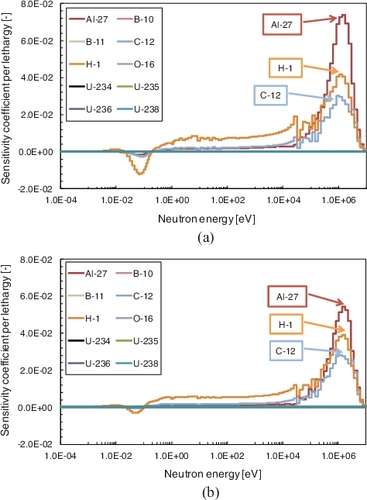
Figure 5. Sensitivity coefficients for inelastic scattering reactions in excess reactivity: (a) EE1 core; (b) E3 core.
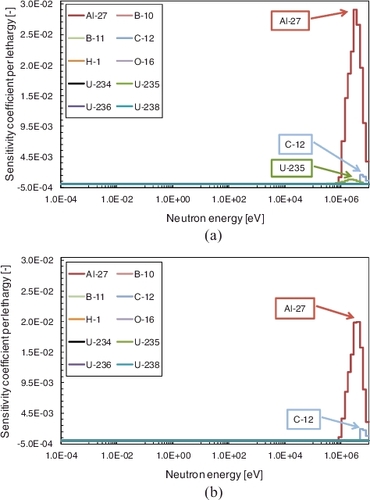
Figure 6. Sensitivity coefficients for capture reactions in excess reactivity: (a) EE1 core; (b) E3 core.

Further study of the sensitivity coefficients was made of keff (worth of C1 control rod) at EE1 and E3 cores, since the worth of C1 control rod was mostly larger in both EE1 and E3 cores, compared with other reactivities shown in . Also, the worth of C1 control rod was selected to investigate directly the effect of the boron isotope component of the control rod. As shown in (a,b), the sensitivity coefficients of 27Al, 10B, 1H, and 235U were negative in the capture reactions; among these, the capture cross sections of 27Al and 235U were highly sensitive in the thermal neutron region, as well as for capture reactions in the excess reactivity shown in (a,b). Moreover, the sensitivity coefficient of 27Al was remarkably large in the E3 core with a thermal neutron spectrum, as shown in (b), as was that of 235U. Finally, in C1 control rod worth, sensitivity coefficient of 10B was found relatively of negligible significance due to an insertion of C1 control rod, although that of 27Al comprising of core components (U-Al alloy fuel plates and Al sheath) was large.
4.3. Uncertainty
The uncertainty analyses by the UNCERTAINTY code of the MARBLE system were conducted with the use of JENDL-4.0 covariance data (107-energy-group). Since the covariance data of 27Al, 12C, and 1H isotopes consisted mainly of core components are not contained in JENDL-4.0, uncertainty analyses were executed for various reactions of 10, 11B, 16O, and 235, 238U isotopes comprising of control and fuel rods in the KUCA A-core, including capture, elastic scattering, inelastic scattering, fission, and (n, 2n) reactions covered in the SAGEP code. As shown in , the uncertainty of excess reactivity in EE1 core induced by covariance data was large, total uncertainty 135.8 pcm, compared with an experimental error of 6 pcm (). The value of total uncertainty was acquired through the square root of the sum of squares for reaction-wise contributions. Among the isotopes, uncertainty was dominant over the sum of all contributions, including the capture and fission reactions of 235U; a large contribution [Citation12] was attributable to the sensitivity coefficients of 235U capture and fission reactions. For the worth of C1 control rod in E3 core, the total uncertainty was 164.1 pcm, although the reaction-wise contribution was slight in the boron isotopes, as shown in , demonstrating the same tendency of excess reactivity as in EE1 core shown in . Finally, the uncertainty of keff in excess reactivity and control rod worth (C1, C2, and C3 rods) was summarized around 150 pcm in the EE1 and E3 cores.
Table 6. Reaction-wise contribution (pcm) to excess reactivity induced by covariance data of JENDL-4.0 in EE1 core
Table 7. Reaction-wise contribution (pcm) to worth of C1 control rod induced by covariance data of JENDL-4.0 in E3 core
Furthermore, the effect of decreasing uncertainty induced by nuclear data on calculated keff was investigated by the cross-sectional adjustment method [Citation30,Citation31], with the use of uncertainty of keff values. The result of this investigation demonstrated a great improvement from around 150 to 3 pcm induced by nuclear data of JENDL-4.0 in all excess reactivity and control rod worth in EE1 and E3 cores. Moreover, by applying the cross-sectional adjustment method to the uncertainty analyses, the C/E value of all excess reactivity and control rod worth in both EE1 and E3 cores reached around a unit.
5. Conclusion
Sensitivity and uncertainty analyses were conducted with the combined use of experimental results (excess reactivity and control rod worth) carried out at KUCA and numerical simulations by the MCNP6.1 calculations, the SRAC2006, and MARBLE code systems. The experimental value was compared with the calculated one by the deterministic approach with the covariance data of JENDL-4.0. Sensitivity and uncertainty analyses demonstrated that the impact of 27Al and 235U was remarkably large in the KUCA A cores, respectively. Moreover, the numerical results revealed the quantitative evaluation (about 150 pcm) of uncertainty induced by the JENDL-4.0 data library in the A cores. Also, these results indicated that further investigation is needed of the numerical analyses of uncertainty of 27Al composed mainly of core components in the A cores, with the use of 27Al covariance data, in order to assess the effect of the uncertainty of 27Al cross sections on reactivity. Finally, a series of uncertainty analyses of keff obtained from excess reactivity and control rod worth in the KUCA A cores is expected to clarify the uncertainty of sub-criticality obtained in the ADS experiments with spallation neutrons carried out in the KUCA A cores.
Supplementary_Data.doc
Download MS Word (56.5 KB)Acknowledgments
This work was supported under the project of Basic Research for Nuclear Transmutation Techniques by Accelerator-Driven System, a Special Research Program funded by Chubu Electric Power Co., Inc.
Disclosure statement
No potential conflict of interest was reported by the authors.
Additional information
Funding
References
- Misawa T, Unesaki H, Pyeon CH. Nuclear reactor physics experiments. Kyoto, Japan: Kyoto University Press; 2010.
- Pyeon CH, Hirano Y, Misawa T, et al. Preliminary experiments for accelerator driven subcritical reactor with pulsed neutron generator in Kyoto University Critical Assembly. J Nucl Sci Technol. 2007;44:1368–1378.
- Pyeon CH, Hervault M, Misawa T, et al. Static and kinetic experiments on accelerator-driven system with 14 MeV neutrons in Kyoto University Critical Assembly. J Nucl Sci Technol. 2008;45:1171–1182.
- Pyeon CH, Shiga H, Misawa T, et al. Reaction rate analyses for an accelerator-driven system with 14 MeV neutrons in Kyoto University Critical Assembly. J Nucl Sci Technol. 2009;46:965–972.
- Lim JY, Pyeon CH, Yagi T, et al. Subcritical multiplication parameters of the accelerator-driven system with 100 MeV protons at the Kyoto University Critical Assembly. Sci Technol Nucl Install. 2012; 395878:9.
- Pyeon CH, Azuma T, Takemoto Y, et al. Experimental analyses of external neutron source generated by 100 MeV protons at the Kyoto University Critical Assembly. Nucl Eng Technol. 2013;45:81–88.
- Pyeon CH, Nakano H, Yamanaka M, et al. Neutron characteristics of solid targets in accelerator-driven system with 100 MeV protons at Kyoto University Critical Assembly. Nucl Technol. 2015;192:181–190.
- Lagrange JB, Planche T, Yamakawa E, et al. Straight scaling FFAG beam line. Nucl Instrum Methods A. 2013;691:55–63.
- Yamakawa E, Uesugi T, Lagrange JB, et al. Serpentine acceleration in zero-chromatic FFAG accelerators. Nucl Instrum Methods A. 2013;716:46–53.
- Pyeon CH, Yamanaka M, Endo T, et al. Experimental benchmarks on kinetic parameters in accelerator-driven system with 100 MeV protons at Kyoto University Critical Assembly. Ann Nucl Energy. 2017;105:346–354.
- Pyeon CH, Fujimoto A, Sugawara T, et al. Validation of Pb nuclear data by Monte Carlo analyses of sample reactivity experiments at Kyoto University Critical Assembly. J Nucl Sci Technol. 2016;53:602–612.
- Pyeon CH, Fujimoto A, Sugawara T, et al. Sensitivity and uncertainty analyses of lead sample reactivity experiments at Kyoto University Critical Assembly. Nucl Sci Eng. 2017;185:460–472.
- Tsujimoto K, Sasa T, Nishihara K, et al. Neutronics design for lead-bismuth cooled accelerator-driven system for transmutation of minor actinide. J Nucl Sci Technol. 2004;41:21–36.
- Abderrahim HA, D'hondt P. MYRRHA: a European experimental ADS for R&D applications status at mid-2005 and prospective towards implementation. J Nucl Sci Technol. 2007;44:491–498.
- Fukushima M, Kitamura Y, Kugo T, et al. Benchmark models for criticalities of FCA-IX assemblies with systematically changed neutron spectra. J Nucl Sci Technol. 2016;53:406–424.
- Shibata K, Iwamoto O, Nakagawa T, et al. JENDL-4.0: a new library for nuclear science and technology. J Nucl Sci Technol. 2011;48:1–30.
- Goorley JT, James MR, Booth TE, et al. Initial MCNP6 release overview – MCNP6 version 1.0. 2013. ( LA-UR-13-22934).
- Chadwick MB, Oblozinsky P, Herman M, et al. ENDF/V-II.0: next generation evaluated nuclear data library for nuclear science and technology. Nucl Data Sheet. 2006;107:2931–3060.
- Okumura K, Kugo T, Kaneko K, et al. SRAC2006: a comprehensive neutronic calculation code system. 2007. ( JAERI-Data/Code 2007-004).
- Yokoyama K, Hazama T, Numata K, et al. Development of comprehensive and versatile framework for reactor analysis, MARBLE. Ann Nucl Energy. 2014;66:51–60.
- Fowler TB, Vondy DR. Nuclear reactor core analysis code: citation. 1969. ( ORNL-TM-2496, Rev. 2).
- Hara A, Takeda T, Kikuchi Y. SAGEP: two-dimensional sensitivity analysis code based on generalized perturbation theory. 1984. ( JAERI-M 84-027).
- Hazama T, Chiba G, Sugino K, et al. Development of fine and ultra-fine group cell calculation code SLAROM-UF for fast reactor analysis. J Nucl Sci Technol. 2006;43:908–918.
- Usachev LN. Perturbation theory for the breeding ratio and for other number ratios pertaining to various reactor processes. J Nucl Energy. 1964;18:571–583.
- Gandini A. A generalized perturbation method for bi-linear functionals of the real and adjoint neutron fluxes. J Nucl Energy. 1967;21:755–765.
- Cecchini GP, Salvatores M. Advances in the generalized perturbation theory. Nucl Sci Eng. 1971;46:304–309.
- Kobayashi K. Reactor physics. Tokyo, Japan: Corona Publishing Co. Ltd.; 1996. Japanese.
- Cacuci DG. On the neutron kinetics and control of accelerator-driven systems. Nucl Sci Eng. 2004;148:55–66.
- Broadhead BL, Rearden BT, Hopper CM, et al. Sensitivity- and uncertainty-based criticality safety validation techniques. Nucl Sci Eng. 2004;146:340–366.
- Dragt JB, Dekker JM, Grupperlaar H, et al. Methods of adjustment and error evaluation of neutron capture cross sections; application to fission product nuclides. Nucl Sci Eng. 1977;62:117–129.
- Cacuci DG, Inoescu-bujor M. Best-estimate model calibration and prediction through experimental data assimilation: I. mathematical framework. Nucl Sci Eng. 2010;165:18–44.

